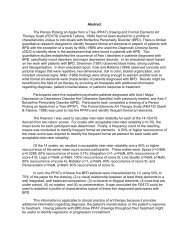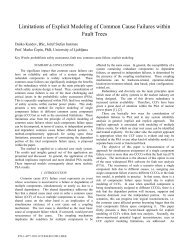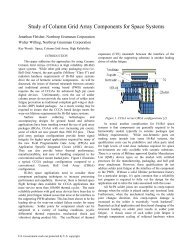Tutorial
Tutorial
Tutorial
You also want an ePaper? Increase the reach of your titles
YUMPU automatically turns print PDFs into web optimized ePapers that Google loves.
eports to identify important summary details visually based<br />
on the data collected.<br />
2.5 How is FRACAS performed?<br />
While specifics will vary, FRACAS processes generally<br />
include these steps:<br />
1. Record the failures or incidents. Critical data associated<br />
with each failure or incident is recorded and stored under<br />
defined procedures, often in a database management<br />
system.<br />
2. Analyze the reported failures or incidents. The root cause<br />
of the failure or incident is identified and stored in the<br />
database management system alongside the original data.<br />
3. Identify necessary corrective action. A corrective action<br />
plan for mitigating the failure or incident is developed,<br />
implemented, and stored in the database management<br />
system.<br />
4. Verify the corrective action. Finally, the effectiveness of<br />
the corrective action is reviewed and recorded in the<br />
database management system and the incident or problem<br />
is closed out per established procedures.<br />
2.6 What are the limitations of FRACAS?<br />
As much as FRACAS can substantially improve products,<br />
services, processes, or computer applications, the difficulty of<br />
efficient application is its inherent limitation. Smart planning<br />
and execution during implementation is paramount, otherwise<br />
the system may fail to manage data efficiently, effectively<br />
identify root causes of problems, or close the FRACAS<br />
process loop correctly.<br />
2.7 Where can I learn more about FRACAS?<br />
As noted in the introduction, many FRACAS resources<br />
are available, including some that define structured<br />
approaches and guidelines for implementation. You can find<br />
several key FRACAS resources listed in the REFERENCES<br />
section.<br />
3. FRACAS BEST PRACTICES<br />
While the general closed loop corrective action process<br />
seems to follow a common sense approach, many factors can<br />
impede its application. Because of the potential challenges, the<br />
following best practices are strongly recommended for use<br />
during FRACAS implementation.<br />
3.1 Set expectations and goals<br />
Prior to deploying the FRACAS corrective action system,<br />
well-defined expectations and goals are essential. These<br />
include the roles and responsibilities of all stakeholders in the<br />
process as well as the objectives of the FRACAS system itself.<br />
All key stakeholders in the process must agree upon the<br />
explicitly defined set of clear expectations and goals. With<br />
these in place, the FRACAS implementation can progress with<br />
clarity of purpose and the system can deploy efficiently and<br />
effectively in line with the defined objectives.<br />
3.2 Involve the stakeholders<br />
The support and involvement of all FRACAS<br />
stakeholders is critical. Many of these stakeholders will<br />
originate within the organization, but customers and/or<br />
suppliers may be involved as well. Involving all appropriate<br />
parties leads to support for gathering sufficient failure data<br />
and unification of a common process across the whole<br />
organization.<br />
3.3 Gain active management involvement<br />
Management involvement and support has a strong<br />
impact on the success of the FRACAS. Active management<br />
participation often results in obtaining and maintaining<br />
necessary funding and resources, and may also provide the<br />
leadership needed to implement and maintain a successful<br />
FRACAS.<br />
3.4 Keep the process simple<br />
The most successful FRACAS solutions are easy to use,<br />
employ user-friendly software tools for automation, and<br />
overall require modest investments in resources and training.<br />
By keeping things simple, active participation from those<br />
outside the quality/reliability is more likely. Ultimately, the<br />
FRACAS must be simple enough for both the expert and<br />
novice to use. Of course, the process design must also allow<br />
for a thorough and effective FRACAS.<br />
3.5 Leverage software tools<br />
Software, either a custom in-house tool or customizable<br />
off-the-shelf solution, is one key way to help to automate the<br />
FRACAS and make it easier to use. Software tools help to<br />
automate data entry, analysis, and output, and provide a<br />
central storage area for FRACAS data and results.<br />
3.6 Provide for efficient data entry and analysis<br />
Entering and analyzing data can be two of the most time<br />
consuming tasks for FRACAS users. Simple web-based forms<br />
can provide for efficient data entry, while automated<br />
calculations, graphs, and reports, along with the ability to<br />
filter the data, can increase the efficiency and effectiveness of<br />
data analysis.<br />
3.7 Supply training<br />
Even when the simplest FRACAS process is<br />
implemented, early training can alleviate the stakeholders’<br />
concerns and foster active participation. As users generate<br />
feedback and the FRACAS evolves, providing additional<br />
training is beneficial for the same reasons.<br />
3.8 Encourage and supply feedback<br />
There are two types of desirable feedback. Feedback from<br />
the users of the FRACAS can help those in leadership roles<br />
focus and streamline the system, while feedback from those in<br />
leadership roles to all participants showcases the results of<br />
their hard work and provides encouragement.<br />
2 – Cline & Stillwell 2012 AR&MS <strong>Tutorial</strong> Notes












